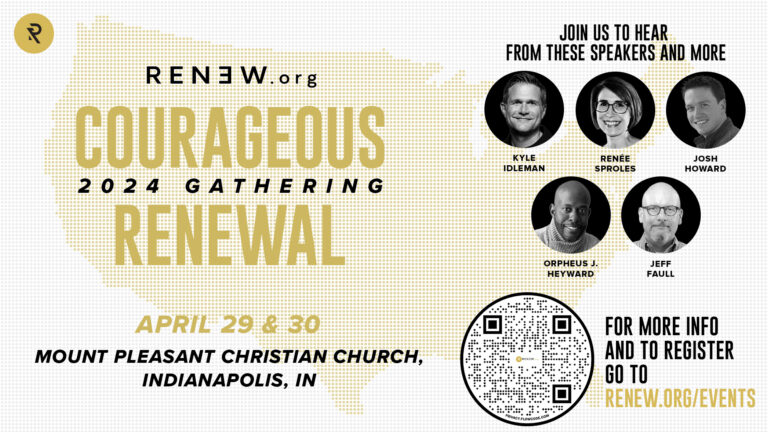Figuring out how to define women’s ministry can be tricky. As a term, most people have heard “women’s ministry” used but may not have given it much thought. Is women’s ministry what women do in the church? Is it ministry to women? Or a combination of both? What is the purpose of women’s ministry?
Women’s ministries have often been put together haphazardly with little reflection upon the design. It often begins as a good idea, then friends are recruited and plans are made. However, what’s often lacking is purpose and intentionality. When we begin a women’s ministry, we need to know our “why.” Why are we beginning a women’s ministry? What is our ultimate goal? The goal of any ministry should be spiritual growth and disciple making, even if it begins as just planting seeds for spiritual growth or constructing bridges between the church and the community.
Let’s use food as a metaphor to consider how a women’s ministry can aid in spiritual growth. When food is laid out on a table at a retreat center, people have the option to choose what to eat based on what is offered. If only desserts are offered, then that retreat isn’t going to help you achieve any kind of balance in your diet. As we design women’s ministries, we need to consider what we are metaphorically offering on the table to make sure that we’re encouraging the women toward a healthy, balanced, spiritual “diet.”
“As we design women’s ministries, we need to consider what we are metaphorically offering on the table to make sure that we’re encouraging the women toward a healthy, balanced, spiritual ‘diet.'”
Over the years of guiding students as they are designing their own women’s ministries, I have found two especially useful systems which both take a balanced, spiritual approach: the “Directional Approach” and what I will call “Elements of a Healthy Woman.”
The Directional Approach
First, there has been a natural gravitation by many toward the “Directional Approach,” and I am unsure of where or how this has originated. This approach uses the orientation of a particular event to provide an organizational structure. The three categories are as follows:
- Upreach: Refers to those events and programs that help women strengthen their relationship with God.
- Inreach: Refers to those events and programs that increase connection within the church family.
- Outreach: Refers to those events and programs that reach out to the community.
While simple, this system easily allows women to make sure that the ministries they are proposing encapsulate elements that create balance, not putting undue focus on just one category. Common concerns about women’s ministry have been that many tend to focus mainly on Upreach or Inreach events and programs to the exclusion of others. Even when good things are happening in one area, balance is needed in the others.
“Even when good things are happening in one area, balance is needed in the others.”
“Elements of a Healthy Woman” Approach
The second approach is what I refer to as “Elements of a Healthy Woman,” and it focuses on those areas women need to grow into healthy women. Chris Adams, editor of Women Reaching Women, helpfully offers four categories of activities that all lead to spiritual growth: relational, physical, emotional, and mental.[1] The approach I’m advocating for here utilizes the original four categories of Chris Adams’s model, but adds another, so that the five elements are relationships, emotional health, physical well-being, knowledge, and spiritual growth. These five categories focus on the areas of growth that women need to become healthy, balanced women.
1. Relationships:
This area focuses on helping women have the tools and opportunities needed to have healthy relationships. This could include events that increase connection and incorporate fellowship and fun. It may also include support groups or seminars that help women develop relational skills or help mend or manage broken relationships in their lives.
2. Emotional Health:
This area focuses on helping women have the tools needed for an emotionally healthy life. This could be support groups or information that deals with issues such as depression, anxiety, infertility, or any variety of stressors that women face. This is different from the Relationships category because this category focuses less on connections with others and more on the internal things going on inside a woman.
3. Physical Well-Being:
This area focuses on providing the tools and opportunities for women to develop physical well-being. This could come in forms of exercise groups, programs on topics promoting good nutrition or beginning an exercise program, programs for young moms on creating nutritious lunches or meals, or lectures on topics for aging women.
4. Knowledge:
This area focuses on helping women gain knowledge needed for success in any area of life. This could include programs or lectures on finances, retirement, gardening, economical cooking, organization, time management, or anything that increases knowledge about a certain topic and helps improve the lives of women. This category is ripe with opportunities to create “Bridge Events,” which are events attractive to people outside the church that can be promoted within the community as a way to build a bridge between the community and the church family.
5. Spiritual Growth:
This area includes those activities that are helping women grow spiritually. Examples of activities include programs providing encouragement or support for personal Bible reading or practicing spiritual disciplines, Bible classes, spiritual retreats, discipleship training, or ladies’ days focusing on spiritual matters. The ultimate goal of spiritual growth is that they become fully devoted disciples of Jesus, who then are able to disciple others to follow Jesus (see Matt. 28:18-20).
“The ultimate goal of spiritual growth is that they become fully devoted disciples of Jesus, who then are able to disciple others to follow Jesus.”
When an academic program is preparing to undergo accreditation, they begin to look at the content of their classes and degrees. Generally, there are different learning objectives that have to be considered for their programs and courses. Different elements are then categorized according to which objective it meets. When it is discovered that one objective is not receiving enough attention, new activities or courses are then designed to fill that hole.
It’s helpful to use the same type of process when evaluating a women’s ministry. Once you decide on an approach, then you evaluate the activities and programs in the women’s ministry to see which category is the most prominent in each one. For example, a ladies’ day could fill spiritual, emotional, or mental categories depending on the focus. For a mentoring program, you would need to consider its primary objective and determine whether it is primarily from the spiritual, relational, or knowledge category. When you discover that one of the categories is not being adequately addressed, then you can develop new approaches to meet that category.
Changing Women’s Ministry
Whatever model you decide on, you’ll want to take into account the new realities of women’s ministry. During previous decades, like other activities within the church, if you scheduled something, you could expect decent participation. However, as new generations are coming through and the schedules of younger women are full with work responsibilities and increasingly complicated children’s schedules, we can no longer depend on a decent size crowd automatically attending an event. We have to be more intentional, better listeners, and focused on meeting the needs of the women where they are.
In previous decades, older women’s ministry tended to be program-based and had calendars full of activities. Any new model needs to recognize that the church is no longer the hub of community, fellowship, and activities. Instead, women can find those things elsewhere. Women will be asking themselves, “Is this going to be worth my while?” They need to see a direct connection to a benefit that will help them fulfill their roles better or grow spiritually; otherwise they may not prioritize the activity. Women’s ministries today need to be people-focused instead of program-focused. Leaders need to be willing to listen, learn, and adapt.
“Women’s ministries today need to be people-focused instead of program-focused.”
Proposing a Women’s Ministry
After you have reflected upon the goals and purpose of your women’s ministry and have selected a tentative structure, it’s time to begin putting things down on paper. Putting together a proposal will help others see your vision for the ministry. I’d encourage you to begin with a page that gives an overview of your vision and include the following items: a purpose statement, a mission statement, and your target audience.
Purpose Statement, Mission Statement, Target Audience
The purpose statement is something that should be detailed enough that it explains what the women’s ministry is about, as well as providing some form for the structure. It should not be so long, however, that it is cumbersome or difficult to memorize.
The mission statement is more succinct but carries the core of what the ministry is trying to accomplish. Some ministries have even chosen a theme verse and used it for this purpose. You will want to be able to use the mission statement on promotional materials as well. One good rule of thumb is to make sure it can fit on promotional items, such as a pen.
Defining your target audience can have a big impact on how your ministry runs. Will you have a starting age at which people can join the women’s ministry? Will the women’s ministry intentionally target and incorporate preteens, high school girls, or college students? Many women’s ministries will want to pick an age at which they begin, but this doesn’t have to be a hard and fast rule.
“Defining your target audience can have a big impact on how your ministry runs.”
Structure
The next page should cover the proposed structure of the women’s ministry. Show how the women’s ministry fits into the church leadership structure. Would it answer to the elders, a subgroup of elders or deacons, a single elder or deacon, or perhaps to the ministry staff? Ask questions to find out how the women’s ministry will fit in.
After you have outlined this, you will give the basic segments of how the women’s ministry will be structured. If you are using the Directional Approach, for instance, this is where you would list “Upreach,” “Inreach,” and “Outreach.” Below those categories you can list out some specific examples of activities that may be a part of those categories.
You might also consider how the women’s ministry itself will be organized. Will you have a coordinator over each segment? Will there be a single or multiple coordinators over the entire ministry? Be sure to include that information where appropriate within the structure. It would be helpful if you gave 1-3 sentences about each of the proposed ministries that you are considering under the subsections.
“You might also consider how the women’s ministry itself will be organized.”
The third page of your proposal should address how the women’s ministry will fit into the church structure. There are often concerns about whether the women’s ministry will follow the overall leadership vision and mission of the church. This is where any unspoken concerns can be put to rest. It also shows how the women’s ministry can take an active role in supporting the overall vision and mission of the church. This is also a good place to explain the thinking behind the balance and structure that has been built into the women’s ministry.
Budget
If a completely new ministry is being proposed, then it’s important to have some idea of what things will cost so you can propose a budget. This is where thinking through the ministry and providing some specific examples will prove helpful.
There are three options for funding activities. First, the church budget can pay for the activity. This could be costs or supplies associated with an event, or it could be materials for a Bible study. Second, the activity or event can be on cost-recovery. This means that for an event, women will either purchase a ticket to cover the expected costs or donate the needed items. Third, the event could be a mix of both.
An easy way to begin identifying where monies may be needed would be to identify those activities that may need some or all of their funding from the church budget. Make an educated guess on how many may attend and do some rough figuring on how much it may cost. Once you have added up those figures, add a little for unexpected expenses. In all reality, even if the amount you request is approved, the amount you actually need will change. It will take a few years to truly figure out how much the ministry costs.
“In all reality, even if the amount you request is approved, the amount you actually need will change.”
Evaluation
On the final page, include some information on how you will evaluate the effectiveness of the women’s ministry. This proposal needs to have enough information to be self-explanatory. However, you should be prepared to make an oral presentation with this as a complement. Resist the temptation to move it from proposal form to a research paper by including too much information. It’s better for someone to come away with a few questions they want to follow up on in person than for them to give up reading the proposal and put it aside for later.
Taking the time to think carefully through a women’s ministry will bring rewards down the line. If you take the time to formulate the goals for the women’s ministry, then you can put a plan in place to get there. Remember, purpose and intentionality are often the missing factors in a women’s ministry. When we can have a clear purpose and be intentional in accomplishing it, we can be more inclusive, effective, and directed in our efforts. The more intentionality you put into this important ministry, the more you’ll realize that it’s worth it.
[1] Chris Adams, Women Reaching Women: Beginning and Building a Growing Women’s Ministry, Revised and Expanded (Nashville: Lifeway Press, 2005), 11.











